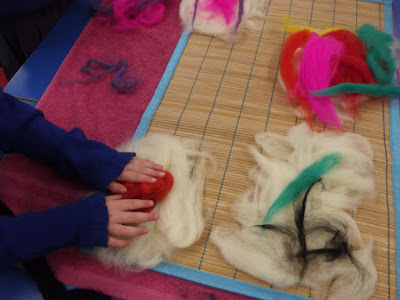 |
| Textile work by diverse artist in response to Cumbrian Art: Picturing Places |
One of the projects I've been working on this year with
Prism Arts is a response project to one of Tullie House's exhibitions. Entitled Cumbrian Art:
Picturing Places the exhibition looks at the museums extensive collection of Cumbrian art and it covers a wide range of Cumbrian landscapes by a variety of artists, past and present.
 |
| Sketching ideas out (RT) |
 |
| Sketching ideas out (MG) |
 |
| Sketching ideas out (MG) |
Tullie House asked us to work with them to find and support diverse artists to create response work to the exhibition which would then be shown alongside the exhibition. We worked on a similar style of project a few years ago when I
mentored a young diverse artist to create work in response to a Richard Slee exhibition at Tullie House.
 |
| Work in progress (HT) |
 |
| Experimenting (MG) |
 |
| Experimenting (RT) |
Originally the plan for this project had been to make an open call to diverse artists but because we were working within quite a tight time frame we made the decision to select artists. We selected four diverse artists who we thought would be inspired by and benefit from this opportunity. In this context we are using the description diverse artist to describe a person experiencing barriers to accessing the art world such as disability, mental health issues or other health issues.
 |
| Work in progress (RT) |
 |
| Trying out ideas (RT) |
 |
| Experimenting with different media (MG) |
One of the issues with creating response work to an exhibition that is going to be shown at the same time as the exhibition is that it doesn't leave a lot of time to create the work! For this exhibition we were fortunate that as the work was coming from Tullie's collection the artists were able to go and see a selection of the work before the show was hung. The museum staff were very helpful, giving the artists access to particular works and providing information on the pieces and the artists. We also arranged for the response work to go up part way through the exhibition to allow the artists time to create their responses.
 |
| Selected and cropped Drawing by HT |
 |
| Selected and cropped Drawing by HT |
 |
| Drawing in progress (HT) |
Even so, time was the biggest challenge of this project. As I was only working with the artists once a week (indeed one of the artists I barely saw at all, luckily she had a very clear idea of the work she wished to make and worked independently) and there was Easter and holidays to accommodate I felt quite pressured time wise but hopefully the artists did not feel too pressured.
 |
Motorway through the Cumbrian Hills
Acrylic and pastel on canvas (MG) |
 |
| Detail: Acrylic and pastel on canvas (MG) |
Working with the artists themselves was a very rewarding process. They all had such different ideas and ways of approaching the project and it was very inspiring seeing them work. My involvement in producing the work was minimal, they all had such a clear idea of what to do and how they wanted to work that aside from a few technical points and small suggestions I did not need to do much on that side of things. One area where I did have more input was in displaying the work as this is an area where the artists had limited experience. For example, one of the artists and myself made the decision to cut up one of his drawings to make two smaller drawings.
 |
| Detail: Cumbria in Thread (RT) |
 |
Detail: ...And if it wasn't red?
Thread wraps on card (NC) |
 |
Detail: ...And if it wasn't red?
Thread wraps on card (NC) |
For this project I have taken more of a project management role. I've really enjoyed this and whilst it has been quite stressful at times and has been a learning curve it's definitely something I would like to do more of. One of the things I really enjoyed was working with Tullie to get all the technical aspects organised such as copy for the press release and leaflets and when and how to hang the work. I really enjoyed writing the copy and helping the artists to write their statements and seeing the finished printed literature is very satisfying.
 |
| Display on our information board about the exhibition |
As the artists had all chosen to work with materials and techniques that made use of resources we already had I was left with a reasonable budget for framing. I very much wanted to get the work professionally framed as I think it finishes the work off and displays it to its full advantage. I chose simple, uniform frames for the work so that the focus would be on the work itself and so that when it was hung in the exhibition space the work of the four artists would work as a mini show on it's own whilst still fitting in with the wider exhibition. Timing was again an issue here, I had to make multiple trips to the framers and next time would definitely make sure there was more time for the framing.
 |
| Hanging the work |
Overall, this has been a really rewarding project to work on. I've learnt a lot and enjoyed being involved in all aspects of the project from idea to display. The show is on until 5th June so there's still time to go and see the exhibition and the work created in response to it.



















































